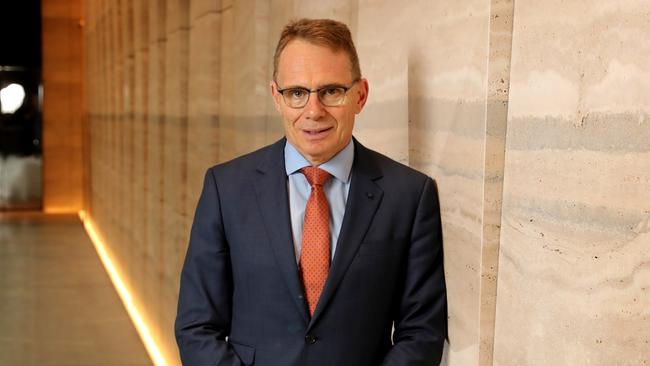Rivals baulk at BHP carbon plan
BHP’s aggressive new stance on downstream emissions should not spread to government policy, the oil and gas industry warns.

BHP’s aggressive new stance on slashing downstream carbon emissions should not spread to government policy, Australia’s oil and gas industry has warned.
The mining giant’s chief executive Andrew Mackenzie this week outlined a plan to set targets on so-called scope 3 emissions, in what represented a significant shift in positions typically held across the resources sector.
Scope 3 emissions take in all activities that can extend to customers, which in BHP’s case include steelmaking and energy.
The miner’s stance is somewhat at odds with many of its peers in the oil and gas industry, which is in the middle of a fight with West Australian regulators over whether to include scope 3 emissions in the environmental assessment of new projects.
Australian Petroleum Production & Exploration Association chief executive Andrew McConville last night said that while he welcomed BHP’s decision to try to tackle its carbon footprint, the new stance should not set an example for policy makers to follow.
“If an individual company determines to go to that point, that’s great and that’s a significant contribution,” Mr McConville said.
“But we don’t see that there is a need in any way, shape or form for governments to be regulating that — that must be an absolute outcome for the industry as a whole.”
BHP’s petroleum arm is itself a member of APPEA.
The oil and gas industry is in an ongoing stand-off with WA’s Environmental Protection Authority over the watchdog’s approach to emissions from major projects.
The EPA earlier this year proposed guidelines that would have required new major industrial projects in the state to fully offset all their emissions from the outset.
The position, which potentially would have threatened tens of billions of dollars worth of proposed developments, triggered a backlash from industry and prompted intervention from the state’s premier, Mark McGowan.
The EPA has since launched an ongoing consultation period over the treatment of greenhouse gas emissions, including whether scope 3 emissions should be assessed as part of its processes, and the oil and gas industry has been adamant that downstream emissions should not be included.
Speaking to the WA Petroleum Club on Tuesday, as Mr Mackenzie was delivering his London speech, Santos chief executive Kevin Gallagher rejected any suggestion there was a role for governments to mandate an approach to scope 3 emissions.
“All that will do is scare off new downstream investment in the very industries that will help the WA Premier meet his target of 150,000 new jobs within five years,” he said.
BHP faces a complex task following its break with industry over downstream emissions as the company seeks to convince the competing interests of activists, institutional investors, governments and its customers of the merits of the move.
Mr Mackenzie’s move was greeted with a muted response yesterday, with analysts more focused on the impact of falling iron ore prices than the miner’s long-term carbon abatement goals.
BHP is believed to have spent the last few months quietly taking the temperature on its scope 3 announcement from major customers ahead of Mr Mackenzie’s speech on Tuesday night.
It now faces the complex task of turning that ambition into goals that can be delivered.
Mr Mackenzie ruled out refusing to supply products to customers that would not take action on their own emissions on Tuesday, saying the company would instead rely on a “coalition of the willing” for its plans.
It has already found willing partners, in June signing a memorandum of understanding with Japan’s Mitsubishi — its partner in Queensland coal fields as well as a customer for other commodities — to work together on emission reduction technologies, an agreement likely to be the template for the deployment of the $US400 million ($572m) fund BHP announced on Tuesday.
It is not due to outline details of how the plan will work until next year, but BHP’s government relations teams will now have to explain its plans to governments across the globe, navigating the complex and divisive politics of climate change policy in each country.
Its product marketing teams will also be fielding customer questions about the likely impact of the push.
Successful industry-led campaigns have generally relied on solidarity between competitors, but it is also unclear whether BHP’s lead will encourage its peers to make similar moves.
Rio Tinto has resisted the push to try to curb downstream carbon release and is seen as unlikely to give ground. And, while BHP spin-out South32 last year began measuring and disclosing downstream emissions caused by its products, it is also seen as unlikely to advance further from that position in the near term.
Swiss mining giant Glencore, the world’s biggest coal producer, made a commitment in February to start reporting on longer-term projections for the intensity reduction of Scope 3 emissions.
Deloitte Energy Transition partner John O’Brien, who leads the accounting giant’s decarbonisation advisory services, said major investors at least were likely to be supportive of the move.
He said institutions were increasingly factoring in climate change strategy into investment decisions and the issue was and not just being pushed by pressure groups such as Climate Action 100 Plus, which claims to represent 320 investors with $US33 trillion under management.
“Where a couple of years ago it might just have been the activist investors, today mainstream global investors are increasingly understanding and assessing the level of climate risk built into the business models of their investee companies,” he said.
Industry-led initiatives have been launched against other global problems, most notably Fortescue Metals chair Andrew Forrest’s campaign against forced labour, with some significant successes.
But Mr O’Brien said the effort required to get users of coal and iron ore to curb emissions would require a “far longer journey”.
“The challenge with Scope 3 emissions is the inability to control the actions of other parties. The approach has to be one of engagement, education, influence and co-operation with suppliers and customers,” he said.

